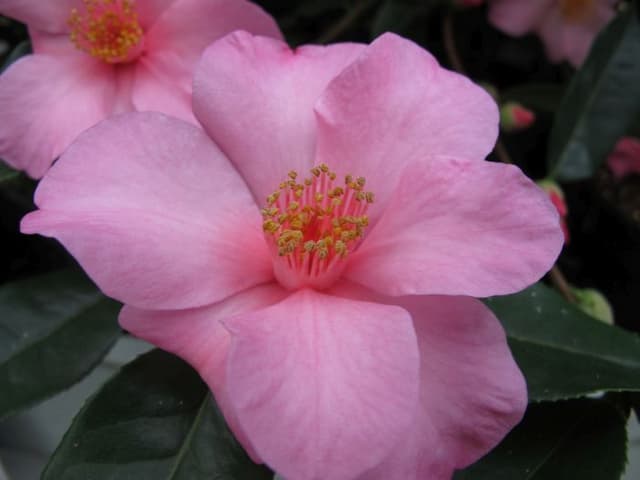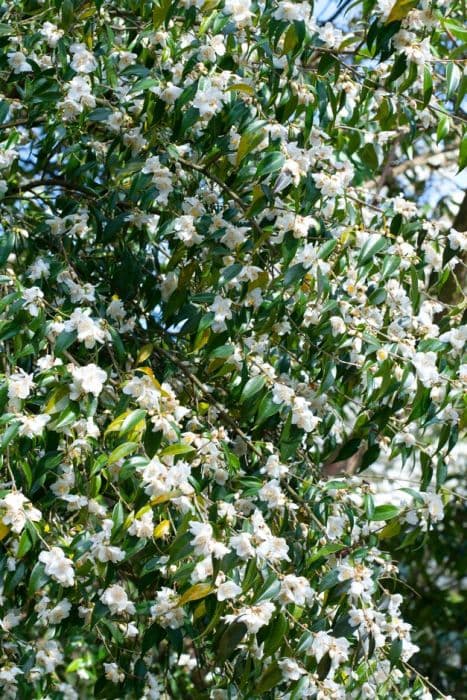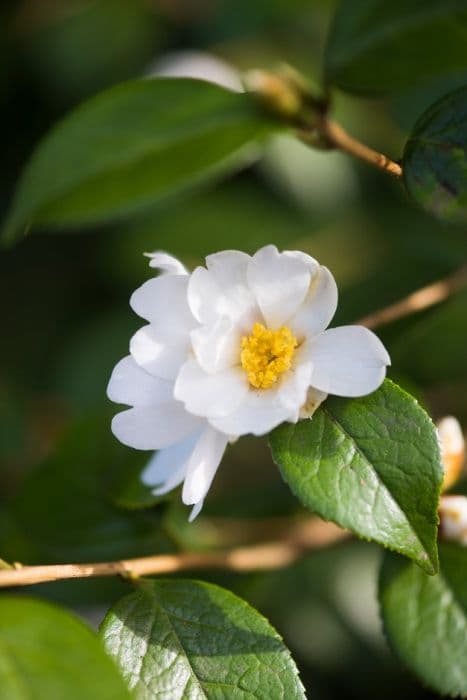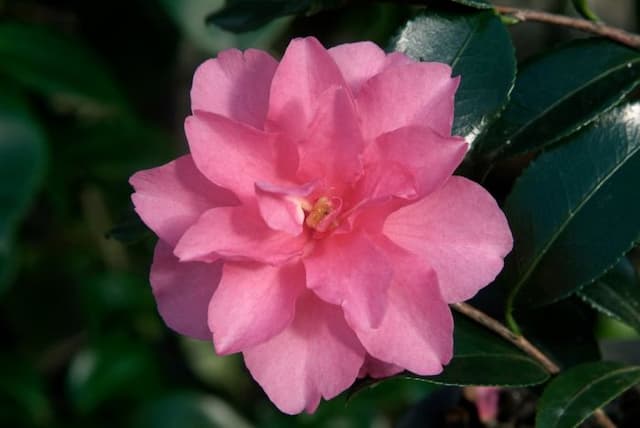Sasanqua Camellia Camellia sasanqua 'Dwarf Shishi'

ABOUT
The Dwarf Shishi is a variety of camellia that features lush, glossy green leaves which provide a rich backdrop for the blossoms it produces. This camellia typically blooms in the fall to early winter season. The flowers are quite striking, showcasing a vibrant pink hue, often with a deeper pink to red toning at the edges of the petals. The blossoms are characterized by multiple layers of petals that create a full, ruffled appearance. These petals may sometimes display a slight twist, adding to the textural interest of the flower. The blooms are complemented by prominent, yellow stamens at the center, offering a contrast to the pink petals and attracting the eyes of onlookers. As for the foliage, the leaves of the Dwarf Shishi are small to medium in size and have an elliptical shape with a pointed tip and serrated edges, creating a delicate look. The leaves maintain their color throughout the year, which makes the plant an excellent choice for those seeking to add a consistent green presence to their garden or landscape. The overall appearance of the Dwarf Shishi is one of elegance and compact beauty, as it showcases its vibrant blooms against a lush evergreen canvas without taking up much space, making it a suitable and attractive addition to various garden settings.
About this plant
 Names
NamesFamily
Theaceae.
Synonyms
Dwarf Shishi Sasanqua, Dwarf Shishi Camellia, Shishi Gashira Camellia.
Common names
Camellia sasanqua 'Dwarf Shishi'.
 Toxicity
ToxicityTo humans
The plant commonly known as Sasanqua Camellia is not considered toxic to humans. There are no well-documented cases of poisoning or toxic reactions in humans from ingesting or coming into contact with parts of the Sasanqua Camellia.
To pets
The plant commonly known as Sasanqua Camellia is generally not considered toxic to pets such as dogs and cats. It is not listed as a poisonous plant, so ingestion of its parts is unlikely to cause symptoms of poisoning or serious health consequences for pets. However, as with any non-food plant, ingestion of large quantities may cause mild gastrointestinal upset in some animals.
 Characteristics
CharacteristicsLife cycle
Perennials
Foliage type
Evergreen
Color of leaves
Green
Flower color
Pink
Height
2-4 feet (0.6-1.2 meters)
Spread
2-4 feet (0.6-1.2 meters)
Plant type
Shrub
Hardiness zones
7
Native area
Japan
Benefits
 General Benefits
General Benefits- Compact Size: Ideal for small gardens or spaces with its dwarf form, allowing for versatile landscaping use.
- Ornamental Flowers: Produces attractive, semi-double to double pink flowers that enhance garden aesthetics.
- Low Maintenance: Requires minimal pruning and care once established, making it ideal for busy gardeners.
- Evergreen Foliage: Keeps its glossy green leaves year-round, providing continuous visual interest.
- Drought Tolerance: Can withstand periods of dry conditions after it is established, reducing the need for frequent watering.
- Adaptable: Thrives in a variety of soil types as long as they are well-drained.
- Container Growth: Can be grown in pots or containers, making it suitable for decks, patios, and balconies.
- Privacy Screening: Can be used as a privacy hedge due to its dense foliage when planted in a row.
- Attracts Wildlife: The flowers can attract pollinators such as bees and butterflies to the garden.
- Long Blooming Period: Offers a lengthy bloom time from fall to winter, providing color during the typically dull seasons.
- Resistance to Pests: Generally resistant to pests and diseases, ensuring a healthy plant with fewer chemical treatments.
- Deer Resistance: Often not preferred by deer, which can help preserve the garden in areas with deer populations.
 Medical Properties
Medical PropertiesThis plant is not used for medical purposes.
 Air-purifying Qualities
Air-purifying QualitiesThis plant is not specifically known for air purifying qualities.
 Other Uses
Other Uses- Camellia sasanqua 'Dwarf Shishi' blossoms can be used to make a natural fabric dye, giving textiles a soft yellow to greenish hue, depending on the mordant used.
- Floral arrangements often incorporate Sasanqua camellia buds and flowers due to their long vase life and elegant appearance. They are particularly popular in ikebana, the art of Japanese flower arrangement.
- The waxy petals of the Sasanqua camellia can be used to create floral-scented candles, with the petals embedded in the wax for decorative effect.
- Sasanqua camellia leaves, when dried and fermented, have historically been used as a substitute for tea, although they do not contain caffeine like true tea leaves.
- Camellia oil, derived from the seeds of the plant, is used for protecting and conditioning traditional hand tools, such as chisels and knives, helping to prevent rust and wear.
- Wood from the Sasanqua camellia can be used in woodworking for inlays and fine detailing, appreciated for its grain and texture.
- Pressed flowers of the Sasanqua camellia can be used in art crafts, such as card making or decoupage, where the durable petals retain their color well.
- The petals of Sasanqua camellia can be added to bath salts or bombs to create a luxurious and visually appealing bathing experience.
- Sasanqua camellia is sometimes grown as a bonsai subject, valued for its small leaves, attractive flowers, and the ease with which it can be shaped and maintained.
- The plant's glossy evergreen foliage can be used as a long-lasting greenery in wreaths and garlands, particularly around the festive season.
Interesting Facts
 Feng Shui
Feng ShuiThe Camellia is not used in Feng Shui practice.
 Zodiac Sign Compitability
Zodiac Sign CompitabilityThe Camellia is not used in astrology practice.
 Plant Symbolism
Plant Symbolism- Perfection: The camellia's lush petals and perfectly arranged leaves often symbolize the ideal of perfection in many cultures.
- Admiration: Gifting camellias can express one's admiration for someone else, recognizing their excellence and beauty.
- Love and Affection: In some traditions, especially in Japan, the giving of a camellia is associated with expressing love or affection.
- Long-lasting Devotion: Due to its evergreen nature, camellias can represent the enduring and unchanging aspect of love.
- Gratitude: Some cultures give camellias to convey gratitude and thanks.
 Water
WaterThe Dwarf Shishi Camellia prefers consistent moisture and should be watered when the top inch of the soil feels dry to the touch. It typically requires watering once every week during active growth seasons like spring and summer, but less often during the dormant winter months. Depending on the size of the plant and the environmental conditions, a thorough watering might require around 1 to 2 gallons of water to saturate the root zone properly. It's important to avoid over-watering which can lead to root rot. Ensure good drainage in the pot or the planting area to prevent water from pooling at the roots.
 Light
LightDwarf Shishi Camellias thrive in partial shade with filtered sunlight. They benefit from protection from the hot afternoon sun, especially in the Southern regions. An ideal spot would be under the canopy of taller trees that allows dappled sunlight or on the north or east side of a building where it can receive bright morning light and be shielded from intense afternoon rays.
 Temperature
TemperatureThe Dwarf Shishi Camellia is hardy and can tolerate temperatures as low as 10 degrees Fahrenheit but performs best in a range between 50 to 80 degrees Fahrenheit. These camellias prefer cooler climates and may struggle in regions where temperatures consistently exceed 90 degrees Fahrenheit. Protecting the plant from frost and extreme cold is crucial for its survival, but they are generally resilient once established.
 Pruning
PruningPruning Dwarf Shishi Camellias promotes healthy growth, maintains an attractive shape, and encourages flowering. Prune the plant just after the flowers fade in late winter or early spring. Remove any dead or weak branches, thin out dense areas to improve air circulation, and shape the plant as desired. Pruning too late in the season can remove the next season's buds, so timing is critical.
 Cleaning
CleaningAs needed
 Soil
SoilThe Sasanqua Camellia thrives in well-draining, acidic soil with pH between 5.5 and 6.5. A mix of 50% peat moss or pine bark, 30% garden soil, and 20% perlite or sand is ideal. Ensure the soil remains moist but not waterlogged.
 Repotting
RepottingSasanqua Camellias should be repotted every 2-3 years. Choose a slightly larger container each time to allow for growth.
 Humidity & Misting
Humidity & MistingSasanqua Camellia prefers moderate to high humidity levels, ideally around 40-60%. Avoid placing in dry, arid environments.
 Suitable locations
Suitable locationsIndoor
Place in bright, indirect light with high humidity for Sasanqua Camellia.
Outdoor
Plant in partial shade with shelter from harsh elements for Sasanqua Camellia.
Hardiness zone
7-9 USDA
 Life cycle
Life cycleThe life of the Dwarf Shishi Camellia begins as a seed, which germinates in favorable conditions of moisture and temperature to produce a small seedling. This seedling then grows into a juvenile plant, establishing a root system and producing its first true leaves. As it matures, it develops a woody stem and a lush foliage of glossy, evergreen leaves, entering its vegetative stage. When the Dwarf Shishi reaches maturity, which can vary from 2 to 5 years, it begins its reproductive stage, flowering annually in the fall or early winter with clusters of small, peony-like blooms that can be white, pink, or red. Following pollination, the flowers develop into dry, globular seed capsules which eventually release seeds, thus completing the cycle. During its lifetime, which can extend beyond 10 years with proper care, the Dwarf Shishi Camellia will experience multiple cycles of growth, flowering, and seed production.
 Propogation
PropogationPropogation time
Autumn-Winter
The Camellia sasanqua 'Dwarf Shishi', commonly known as Sasanqua camellia, is often propagated by semi-hardwood cuttings. This method is most successful when implemented in the late summer. To do this, a grower selects a healthy stem that has recently matured and cuts a segment typically 4 to 6 inches (about 10 to 15 centimeters) long. The leaves on the lower half of the cutting are removed, and the cut end is dipped in a rooting hormone to enhance root development. Then, the cutting is placed in a well-draining potting mix. The environment should maintain high humidity and should not be too bright, as direct sunlight can harm the developing plants. It is vital to keep the soil moist but not soggy to encourage root growth without causing rot.









